Saturday 9th April 2022

Located towards the south western tip of Lincolnshire 23 miles south of the county town of Lincoln, 22 miles east of Nottingham, 29 miles north of Peterborough and 31 miles west of Boston, Grantham’s population is around 45,000 so is typical of the mid size towns I’m aiming to visit as part of my fortnightly alphabetical wanderings around Britain.

Grantham doesn’t have much of a hinterland; being surrounded by agricultural rurality. And fairly flat at that.

Aside from being famed as the birthplace of Isaac Newton and former Prime Minister Margaret Thatcher it’s well known as a market town staging post on the original A1 and, more pertinent to this public transport review, a prominent presence on the East Coast Main Line.
Grantham’s railway station is not exactly imposing, but is quite a substantial affair and has been significantly refurbished in recent years.

It’s managed by LNER with four platforms comprising an island platform (platforms 2 and 4) for northbound departures incorporating a north facing bay (platform 3) used by EMR trains on the Nottingham to Skegness route.
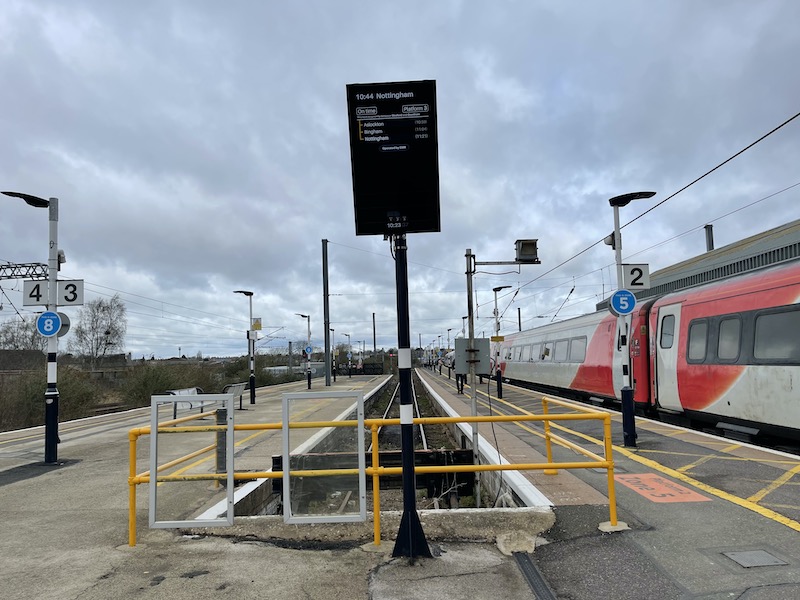
There’s a varied selection of destinations served by train for a town of its size but these do vary from one hour to the next. Between 10:00 and 11:00 for example two departures will whisk you to Kings Cross (with Hull trains at 10:00 and LNER at 10:19), as well as Norwich, Liverpool, Nottingham and Skegness (with EMR), Hull (with Hull Trains) and Harrogate (including Leeds) and York (with LNER).
The following hour has a slightly different pattern including a Lincoln instead of a York (LNER) and no Hull Trains. Between 12:00 and 12:18 there are three trains to Kings Cross then nothing until the next departures at 13:08 and 13:18, so not particularly evenly spaced.
There’s an understandable gripe from Granthamonians about missing out on trains to further afield destinations such as Newcastle and Edinburgh as Scottish bound trains race through the station but you can’t have everything on a congested railway where long distance passengers want speed and uninterrupted journeys devoid of market town stops.
Two gripes of my own I noticed on my visit on Tuesday was LNER still insisting on stopping their five coach Azuma trains right at the far end of the platform thereby inconveniencing passengers especially on a wet day with the train ending up far beyond the covered waiting area as illustrated below. If you’re in coach A its a long walk from covered protection under the canopy to your seat.

And secondly it’s annoying to see the bus stop (albeit with a fairly limited service) has moved further away from the station entrance in the recent revamp.

Instead the space closer to the station has been allocated for “premium parking”.

Another example of LNER’s disinterest in modal integration. Imagine if you’re a passenger who finds walking a bit challenging arriving on a bus from say Barkston on the bus route in from Lincoln and catching a five coach LNER train to Harrogate from platform 2 and you’re seated in the accessible coach A at the front. LNER have made you walk unnecessarily for almost half a mile with these annoyances.
Still at least there were timetables posted at the bus stop, and up to date ones too.

Only two bus routes call at the railway station. Stagecoach’s hourly route 1 from Lincoln calls by on its way into Grantham (but not on the return journey) and Vectare’s 90 minutely route 93 calls in both directions.
The railway station is only a three or four minute leisurely walk from the bus station (through a rather nice alleyway by former railway worker terraced houses ) which in turn is adjacent to the town’s commercial centre including the Isaac Newton Shopping Centre comtaining a large Morrisons.
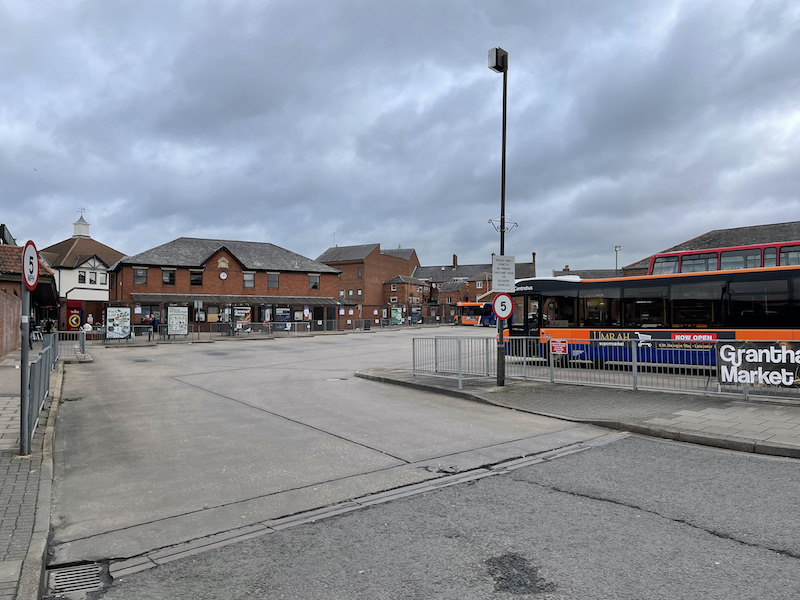
I’ve commented on Grantham’s bus station before. It’s not in its prime but it’s 11 bays, each with a small shelter, are functional and plenty big enough for today’s operations.

The main bus operator in the town is Centrebus which operates Grantham’s three town bus routes and a selection of inter-urban and rural routes. As well as the already mentioned Stagecoach and Vectare (which operate the two routes already highlighted – 1 and 93) there’s Lincolnshire’s long standing DRT style service called Call Connect.

Centrebus is what I’d describe as a sound functional bus company. There’s not a lot of razzamatazz sparkle but there is what comes over as a dependable well presented bus network which looks to be well in tune with the local market operated by clean, brightly painted well driven buses.
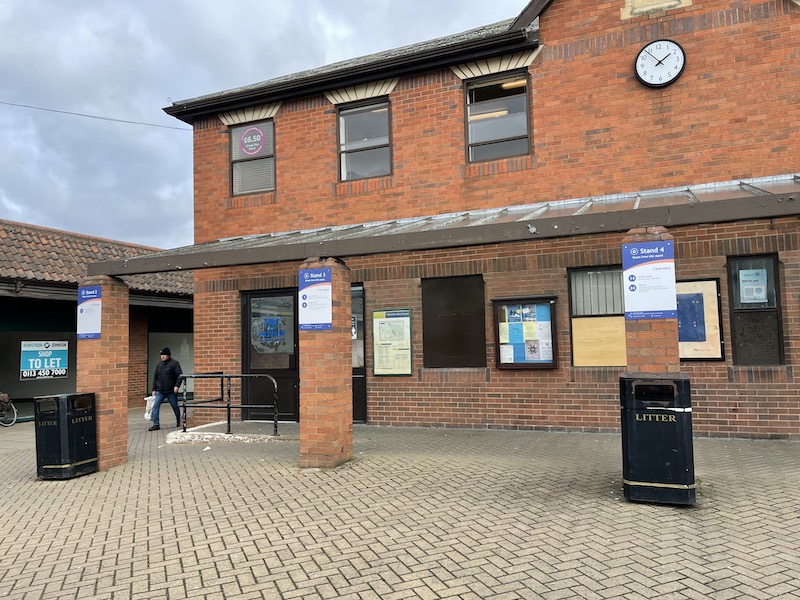
Clear departure bay signage is provided by Centrebus in the bus station (which I’m sure have been added since my last visit) together with clearly conveyed departure times at each stand.

A simple network map is on display as is a list of stand allocations.


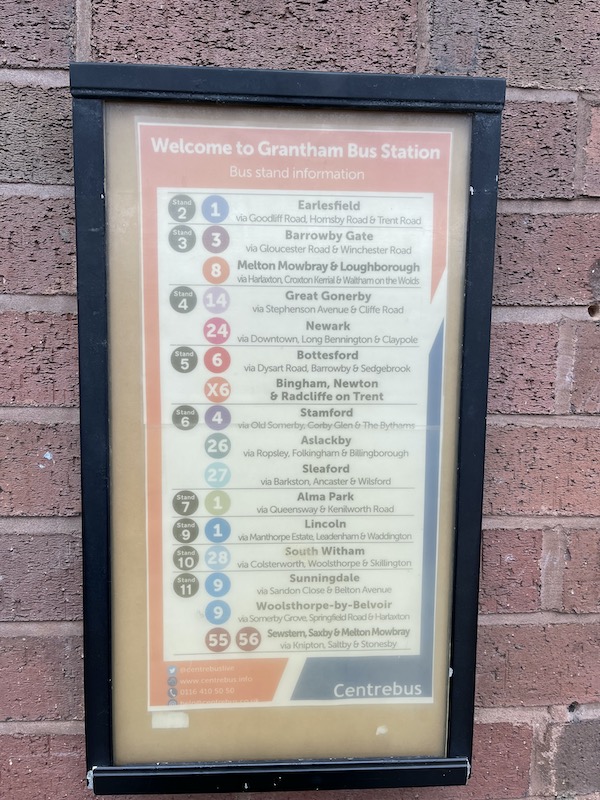
Also displayed is a similar (but differently presented) map and a couple of traditionally laid out timetables which I suspect have been put up (some time ago) by Lincolnshire County Council. They seemed somewhat superfluous.

I took a ride on the three town routes which all operate to a circular pattern at the outer ends. Two of the routes are numbered 1 but timetables show them as separate routes even though many buses operate across the town linking the two routes into one.

I didn’t see any passengers travelling through and sometimes the bus terminated in the bus station – especially around lunch time when drivers changed over and double decks appeared on the route/s.

It’s convenient for passengers travelling from Earlsfield (west) who want the north end of High Street to stay on the bus if it runs through to Alma Park (east).
These route 1 portions run half hourly whereas route 3 to Barrowby Gate (west) runs hourly. You can see why when you travel on the routes with housing density much lower on the latter reflecting the small numbers travelling – two out and three back on the 12:45 rounder whereas the route 1s I travelled on and observed during my visit had 6-8 on each journey. Some journeys even more.

As already mentioned there’s yet another route 1 in town and that’s the hourly Stagecoach route to Lincoln. I’ve taken a ride on this previously – it’s a nice run but nothing spectacular. Numbers travelling were in the high single figures at best.

It used to be branded as part of Lincolnshire’s InterConnect brand but these days it seems to be the case that anything goes with at least two of the workings I saw having Pronto branded vehicles on Tuesday.

Vectare route 93 to Bingham doesn’t serve the bus station which is a bit anomalous for passengers; albeit there aren’t many – I saw two on the 12:30 departure. I wrote a review of this route and others operated by Vectare in the wider East Midlands area back in September 2020.
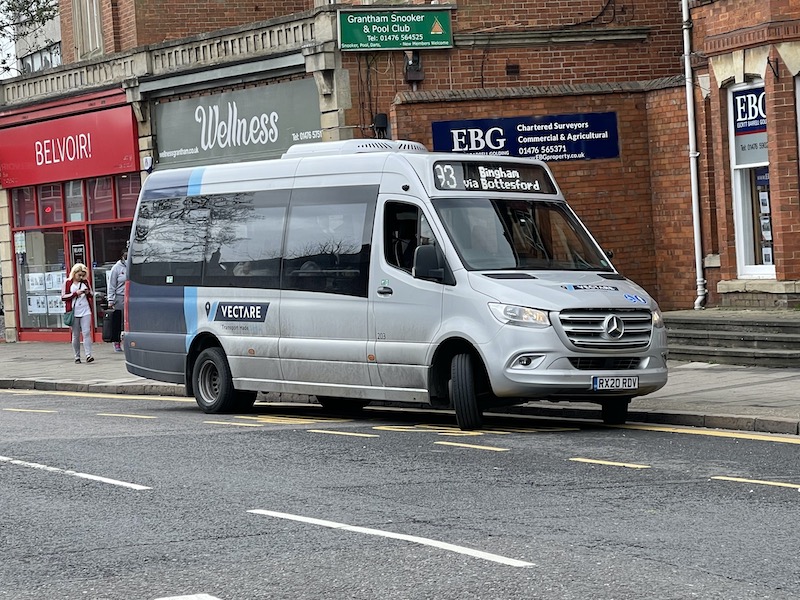
Centrebus also runs hourly to Bottesford (route 6), Melton Mowbray and Loughborough (route 8) and Great Gonerby (route 14) and less frequently to Newark, Sleaford, South Witham and Aslackby.

The departures I saw on all these routes carried what one might call average loadings for current times.


Information provision at bus stops around the town seems to be a County Council responsibility. Aside from traditional timetables posted by Vectare the only message was a rather unhelpful one advising “bus times are not posted at this stop as services can be subjected to frequent changes due to Covid-19”. I’m not sure that encourages passengers to Bus Back Better.

And it’s not much better online with Lincolnshire being one of the counties that favours the Cartogold “inter-active bus map” which basically is a zoomable map of the county showing the location of every bus stop ….

…. which in turn are each clickable to show the route of the bus route/s stopping there including highlighting the route concerned.
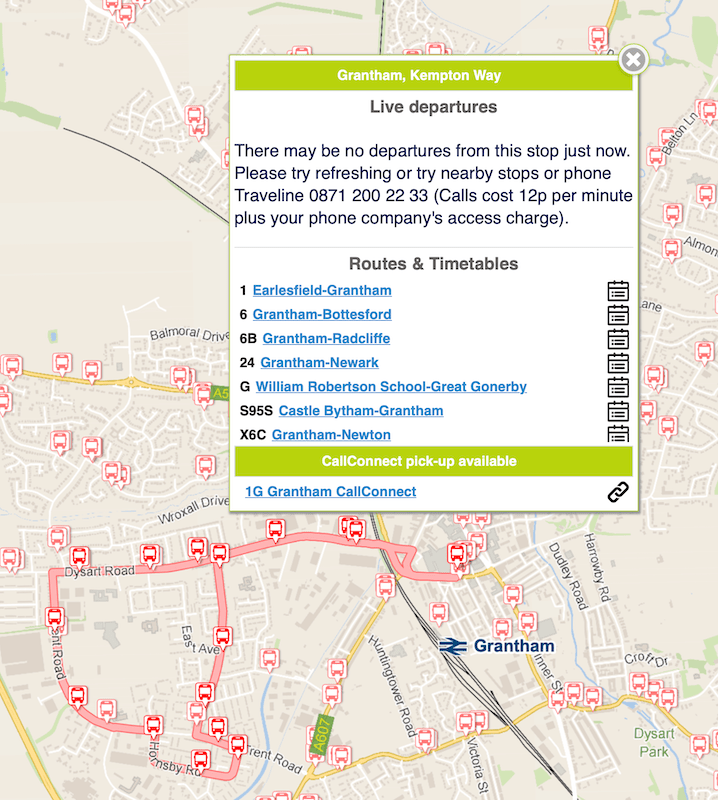
There’s also a bus route listing in number order which is also clickable and will show up on the map.

It’s clever but completely useless for someone wanting a helpful network map of the area. At least there was one (actually two) for Grantham on display in the bus station as highlighted earlier and in a twist to more usual experiences neither seemed available online on either Centrebus or Lincolnshire County Council’s websites, unless I have missed the links.
Centrebus does have a helpful website which displays a map clearly showing where each route goes as well as bus times and fares.

There’s also a bus tracker section which is excellent.

And there’s plenty of information about ticket options including the TANGO – whereby two adults travelling together save 15% on return fares and take two children free at weekends and school holidays which is a great idea.
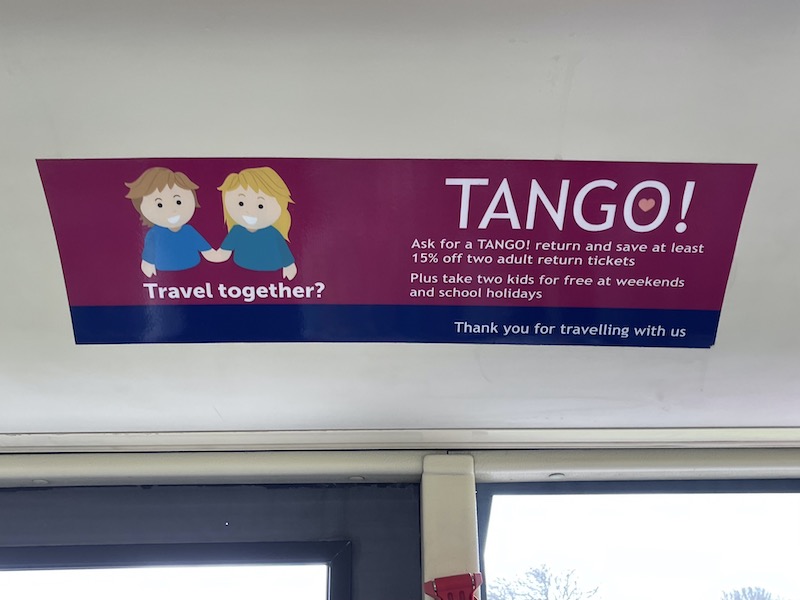
Lincolnshire’s countywide CallConnect service covers the wider Grantham area but is specifically not available for ‘within town’ journeys, other than for those with mobility impairments.

Just to confuse things the buses in the Grantham area also use a route 1, albeit a 1G, presumably the G being for Grantham.
I took a ride on the three-journeys-a-day fixed route 4 (with on-demand route variations as required – the ideal way to run DRT) to Stamford a couple of years ago and wrote about it here.
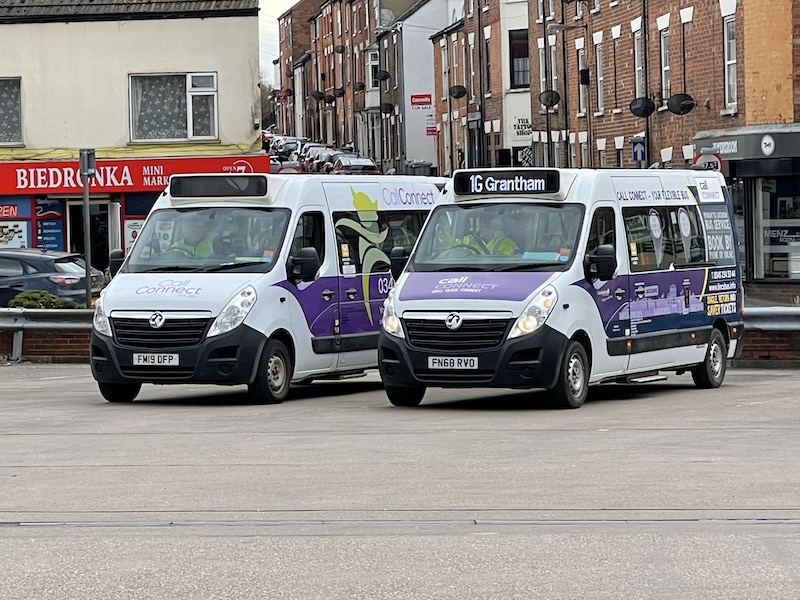
Grantham’s town centre traffic can be a nightmare on busy weekends but was behaving itself on Tuesday and all the buses I saw were operating well to time. All in all it was a decent operation for a decent town.
Roger French
Previous AtoZ blogs: Andover; Bracknell; Carlisle; Durham, Evesham, Folkestone.
Blogging timetable: 06:00 TThS.


It is disappointing that Lincolnshire County Council no longer produce network maps and have moved to this interactive option. It is ridiculous how hard it is to find a decent bus map these days. So many county councils have stopped publishing them.
East Sussex County Council recently moved to the same exact Cartogold interactive map however they have still kept current up to date PDF files of all thirteen network maps (the one county wide map and the twelve local town maps) for people to download and view:
http://www.cartogold.co.uk/EastSussex/index.html
So i do not know why Lincolnshire County Council could not do the same and offer both options like East Sussex County Council have.
LikeLike
I am glad that you added the link. If, as most people looking for an East Sussex transport map would do, you approached it via the County Council website you seem to be told only of their interactive map. To find the pdfs I had to go to the interactive map, from which I can see that I have moved from East Sussex CC to Cartogold, and then click on Home. a procedure that I would not describe as intuitive.
Using the same basis with Lincolnshire did not produce a result. However, by Googling “Lincolnshire Bus Map” I was offered a PDF map, supposedly uploaded March 2020 by lincsbus.info, the county council’s transport website, leading to a 2016 edition of the map. The page is still there, just not showing anywhere if you go directly to their site.
With the availability of software for electronic maps the idea that people might want to have something on paper, whether for convenience or to be able to see the bigger picture, seems to be going. It is not just in the UK. On many operator or transport authority sites you can have what is described as a map when you download a timetable for an individual route but a network map, something from which the use of public transport can be sold, is frequently absent.
LikeLike
If you are not familiar with an area or do not normally use a bus a map is invaluable even more so when in many area no bus stop information is provided at all
I not as well that some of the journeys on some of the routes in Grantham are being cut this month
A good example of a council who gets it right is Herts. They have a Herts County Map, A map for each town and Where to Board your bus maps. Whether paper copies of them are available I do not know. They also have the interactive map that should show the whereabout of bus in real time. It is not very user friendly and very clunky and sometimes it works and sometimes it does not
https://www.intalink.org.uk/services
LikeLike
The “it” designation is used to identify local Into Town routes in other Lincolnshire towns: routes IT1 to 4 in Boston and IT1 and 2 in Spalding, though the Spalding routes are identified also on bustimes.org as F42 which is not shown on the vehicles. These are all operated by Brylaine.
LikeLike
Moving the bus stop away from the station and making passengers walk to the far end of platforms feel like shooting yourself in the foot.
At a time where passenger numbers are still depressed no cost measures should be prioritized. There may be reasons for this, but supply side solutions suggest that passengers are not a priority regardless of the heavy promotion on the television.
Premium parking is another disincentive to leave the car behind. Even at small stations parking charges have appeared leading to cars being parked on surrounding roads, leading to complaints that the railway is a bad neighbour.
LikeLike
Sir Issac Newton wasn’t actually born in Grantham but in Woolsthorpe a hamlet about 15km to the south.I went there about 2 years ago and got the Centrebus service 28 from the bus station.The bus station is a bit run down, probably inherited from Lincolnshire Road Car in NBC times and maybe Trent and East Midland went there too?,but at least they have a bus station which actual Grantham born Lady Thatcher wouldn’t approve of when it could be turned into another car park.The Centrebus livery is rather similar to Stagecoach I thought.I felt Grantham to be a bit rundown on my only visit going outside of the rail station strange considering Mrs,sorry Lady, Thatcher rubbed it in to the very end dying in the Ritz she obviously didn’t send any of her ill gotten loot back to Grantham!
LikeLike
Go-Ahead outlines new strategy
I am unsure what is in gthis strategy that will deliver 30% revenues growth. The bus companies have not managed to win back the passengers lost due to Covid. The bus market as well is still shrinking
The plan is aimed at delivering profitable growth and a sustainable future for the business in what it describes as a dynamic market for public transport. The strategy follows a business review led by Christian Schreyer, Group Chief Executive.
Entitled ‘The Next Billion Journeys’, the new strategy has three priorities: performance improvement, to grow organically and externally and to progress new opportunities by leveraging existing capabilities and resources.
The Group is to target growth in existing geographies, notably the UK regional bus market, as well as in other areas. It hopes to replicate its London and International Bus business model in selected international markets.
Go-Ahead aims to explore new urban mass transit modes, including bus rapid transit, as well as new services within the mobility value chain with existing capabilities and resources, such as zero emission services, Mobility as a Service (Maas) operation and property utilisation. It also wants to accelerate in the B2B market, such as in airport transport and rail replacement services.
To achieve, these objectives, Go-Ahead’s management team aims to prioritise five enablers:
Strengthening governance and transparency
Improving digital and data capabilities
Consolidating Zero Emission capabilities
Rebuilding post-Covid confidence with passengers and clients
Enhancing people engagement and collaboration
The Group is aiming for an increase in annual Group revenue to around £4 billion, up by around 30%, in the medium-term. It also targets an increase in annual Group operating profit to at least £150 million in the medium-term.
LikeLike
I wonder why the hourly Centrebus 8 – which has makes a good, quick journey as far as Melton Mowbray – is timed to avoid decent connections into the hourly trains from Melton to Leicester? Even without the possibility of combined ticketing (why have the commercial bus companies – who for a long time operated trains as well – not cracked this one?), the Bus+Train time could be reasonably near the car journey time. But integration doesn’t seem to be part of anyone’s thinking – except for passengers, in their dreams…
LikeLike
End of the line? Vintage train journeys at risk as coal supply fails
Britain’s heritage railways are running out of steam.. Vintage rail operators across the country have warned that their stocks are now dangerously low and the prospects of replacing them in the near future look bleak.
UK coal for steam trains has now gone and our next supply source was to be Russia, which is now off the table for totally understandable reasons.
LikeLike
Steam locomotives rely on bituminous lump coal to burn, which is relatively smokeless and comparatively clean.
The opencast mine at Dewley Hill, near Newcastle, would have produced this coal but it was rejected for environmental reasons.
LikeLike
Supporting local Bus Services
Could more flexibility with concesionary bus pass help to kep bus services going
Let say an opearate gives a service up as being unprofitable it could be allowed to operate as a not for profit community bus. To help this happen Community buses should be allowed to charge a small fare for concessionary pass holders. This could be the difference between a bus service and no bus service. It would not really impact commercial bus services as if the Community bus duplicate some sections of commercial services most concessionaty pass holder would ue thr bus they did no have to pay on
LikeLike
Bob, The Hertfordshire intalink website is excellent for timetable information ……. but the maps dont seem to be updated which is a bit of a let down.
Take the Royston area map for example, It hasnt been updated to show the Gateway retail park with Richmonds town bus 16 and Stagecoach 915 serving it !!. It will be interesting to see if the Watford area map is updated with all the route changes planned. (By the way, they have their publicity vehicle out and about on the road again. I see its in Baldock soon and i know from past experience, it did contain maps, area timetable books and various timetable leaflets when it was previously on the road, pre covid).
LikeLike
Out of date information is a common problem
With digital maps it should not be that difficult to keep them up to date. If you are familiar with an area a map is probably needed but if you do not know an area a map is pretty much essential although most councils think they are not
Some bus companies produce their own maps but they are of limited use as they just show their own services
LikeLike
First Essex making changes and cuts to Services across Essex
Far too many to list here.
Link here: https://www.firstbus.co.uk/essex/news-and-service-updates/news/17th-april-2022-basildon-south-essex-service-change
LikeLike
It does however clear up your post on 31st March when you suggested whole swathes of services were being “given up” such as much of the Colchester and Chelmsford networks. When you spot the cancellations on that scale, it’s wise to wait for the registrations – the 54/56 group were always going to be replaced.
It’s a long overdue tidy up of the network and I’d hope that Roger (amongst many other things on his plate) might cast his gimlet eye over First Essex.
LikeLike
There are significant cuts to the services with many having the frequency cut by 50%
LikeLike
A mini bus war seems to have broken out with Firdt bus moving in on Arrivas patch in Colchester
LikeLike
Yes Bob, there are significant headway reductions (as we would expect in the post Covid world) but not the wholesale withdrawals that you were alluding to previously. It is very much a mini bus war in Colchester – they have removed their half hourly service through Monkwick, a diversion of the Mersea service, and replaced it with 15 min headway service. Quite an interesting move to see if Arriva will do anything but they have been also widening headways on other Colchester routes
LikeLike
Railways always say theyhave to stop at the head of the platform as that is where the signal is. However why cannot you stop in a sensible place, and then move up tothe signal ?? Guess in some places an extra CCTV camera or mirror might need providing.
LikeLike
Because to move up to the signal would require moving the train possibly against the signals aspect which is how train drivers would get themselves fired!These are the problems that happen when you replace long trains with short ones….all complaints to Sir’s Richard Branson and John Major please!
LikeLike
We always tend, understandably, to judge bus services by the published timetables, which is good as far as it goes. But my experience of FEx is that the greater issue is with the on-the-road service delivery, and its been a longstanding issue, which even at one stage got the TC involved (when they had the resources).
For example I live in a village which had an excellent (albeit ridiculous) 15m headway – though passengers could often endure over 30m, or even an hours wait, so it was hardly surprising that usage was in constant decline. The word is we weren’t alone.
At least now it looks like the timetable is to match the poor delivery. Improvement? In a sense, clearly, yes. We shouldn’t be given unrealistic expectations. Bus back better? I’m not so sure. We won’t be using the bus unless we have to. But at least First are safe. There isn’t any local competition, and they’re probably doing enough to keep them at bay, to turn their attention elsewhere!
LikeLike
Bus station woes in Maesteg, services diverted due cars parking in it!
https://www.walesonline.co.uk/news/wales-news/buses-stopped-using-bus-station-23717705#comments-wrapper
LikeLike